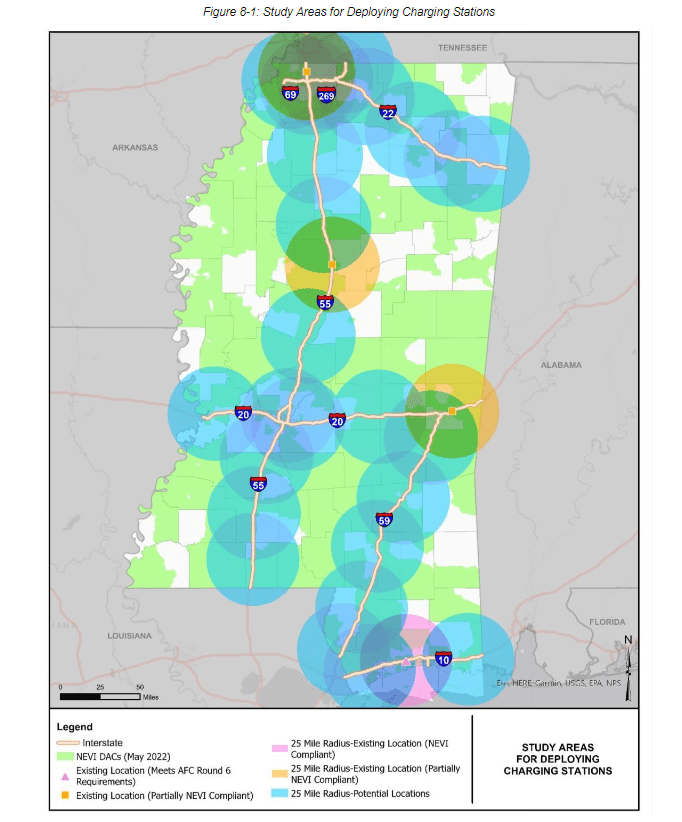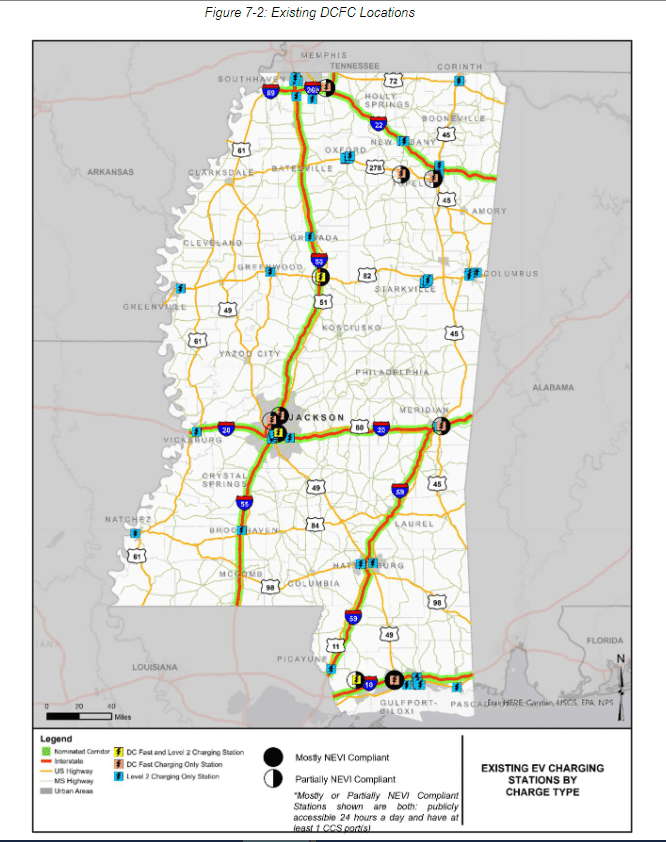Mississippi Today
New EV charging stations two to three years away, MDOT says

No state has fewer public electric vehicle charging stations per capita than Mississippi.
With 145 total stations, the state has just under five for every 100,000 people, much lower than the national rate of 19 per 100,000, according to data from the U.S. Department of Energy.
But with a boost of $50 million in federal funding, Mississippi plans to add about 30 new stations, which will be spread out along the state's busiest highways. Jessica Dilley, the director of Alternative Program Deliveries with the Mississippi Department of Transportation,told Mississippi Today that the agency projects that new charging stations will start showing up by 2026 or 2027.
The $50 million, which came from the Infrastructure Investment and Jobs Act, is coming to the state over a five-year period. As of now, MDOT is still in its planning phase and hasn't spent any of the money.
Dilley said there was an adjustment period for the agency, versus its counterparts in other states that already had electric vehicle programs.
"There are some states nationwide that already had programs before the national program was established," she said. "We are not one of those states. So we spent time coordinating with the industry and educating ourselves... as well as coordinating with the utilities, the energy department, and communities throughout our state."
As far as where the new stations will go, MDOT is planning to build between 25 to 30 new locations along I-10, I-20, I-22, I-55, I-59, I-69 and I-269. In order to meet federal requirements, stations have to be spaced no more than 50 miles apart from each other, and no more than a mile from the nearest interstate. The average cost of each new station, MDOT estimates, is between $500,000 and $1.5 million.
MDOT is issuing two rounds of request for proposals, Dilley said. The first round will be issued by the end of this year, with awards going out by mid-2025. Based on what's happened in other states, she said, it'll take anywhere from six months to a year after contracts are awarded until the stations are up and running.
There are a wide range of companies that may put in bids to run the new stations, Dilley added.
"What we've seen from adjacent states is everywhere from Waffle Houses putting in (bids) to Tesla, and everything in between," she said. "So it'll be up to whoever submits to apply for the funding to put in the station."
Companies that win bids will be responsible for 20% of the station costs, and MDOT will use its federal dollars to pay for the rest. Each station will have to have four DC fast chargers, each supplying 150 kilowatts at a time.
Mississippi's current charging stations, as shown in the map above, are spread out around the state, but most of them lack the capacity that the new stations will carry.
During the agency's public engagement, Dilley said MDOT received over 2,700 comments in the first year of the program. She said a "good amount" of the responses expressed "resistance" towards the program, because they were against electric vehicles in general or because the program is being funded publicly rather than privately. Other commenters were supportive, Dilley said, showing interest in reducing fuel emissions.
As part of the federal requirements for receiving the funds, Mississippi has to submit annual plans for building electric vehicle infrastructure, which the public can view on MDOT's website. Dilley said the agency will continue to engage with the public and post updates online.
This article first appeared on Mississippi Today and is republished here under a Creative Commons license.
Did you miss our previous article...
https://www.biloxinewsevents.com/?p=331396
Mississippi Today
On this day in 1967
MAY 12, 1967

Benjamin Brown, a former civil rights organizer, was shot in the back on this day in Jackson, Mississippi.
Brown had walked with a friend into the Kon-Tiki Café to pick up a sandwich to take home to his wife. On his way back, he encountered a standoff between law enforcement officers and Jackson State University students, who had been hurling rocks and bottles at them. Brown was hit in the back by three shotgun blasts. No arrests were ever made, and the Mississippi Sovereignty Commission gathered spy files on the students who protested.
Eyewitnesses pointed their fingers at then-Mississippi Highway Patrolman Lloyd Jones, who reportedly admitted his involvement in the killing. When some accused a Jackson police detective of killing Brown, Jones was quoted as replying that the detective “didn't shoot that n—–, I did.”
Jones was quoted as saying that he took the shotgun home, cleaned it, wrapped it in a blanket and placed it in an attic for a few months before returning it to service. Jones was never charged and in 1995 was killed while working as sheriff in Simpson County.
This article first appeared on Mississippi Today and is republished here under a Creative Commons license.
Mississippi Today
If you didn’t like MAEP, you may not like the new public school funding formula
House and Senate members often adjourn a legislative day in memory of a constituent or other well known person who recently died.
On the day the Mississippi House took its final vote to adopt a new school funding formula, Rep. Karl Oliver, R-Winona, asked “to adjourn in memory of the Mississippi Adequate Education plan…the failed plan.”
Oliver continued: “It has always failed and never met its expectations. Today we laid it to rest.”
House Speaker Jason White, R-West, gleefully responded that all House members might want to sign onto Oliver's adjourn in memory motion.
Of course, the Senate went on to pass the bill rewriting the Adequate Education Program and Gov. Tate Reeves, a long-time opponent of MAEP, signed the legislation into law this week, no doubt stirring much celebration for folks like Oliver and White.
But for those celebrating the demise of MAEP, be warned with a paraphrased song lyric: Meet the new school funding formula, same as the old school funding formula.
The core principle of the Mississippi Adequate Education Program lives in the new funding formula, named simply the Mississippi Student Funding Formula.
Like MAEP, the new formula uses an objective formula to determine the base student cost (amount of funding per student) and provides that amount of money multiplied by school enrollment or attendance to each local school district.
And here's the kicker: Like MAEP, the Mississippi Student Funding Formula mandates that the Legislature appropriate that amount of money annually to each local district.
The new law states plainly, “Base student cost shall not be lower than the previous year.” So that means the new law mandates lawmaker provide enough funds to pay for what will likely be an ever increasing base student cost or, if they don't want to fully fund education, they have to hope enrollment drops or they simply do like they did with MAEP and not follow the law. The new law does provide a small loophole, saying when a revenue shortfall is so severe that state budgets must be cut, education also can be reduced.
But the new law goes on to say, “If the total revenue increases the following year, the formula shall be recalculated or increased.” Just like MAEP, the amount of money called for by the formula is adjusted yearly for inflation. And it is recalculated every fourth year, meaning unless there are unusual circumstances the formula will generate more money for education each year.
For years, many politicians, including the governor, argued that the state could not afford MAEP's objective funding formula. So, while cutting taxes by more than a billion dollars annually, legislators chose to ignore the law saying MAEP “shall” be fully funded. At the same time those tax cuts were being enacted, many legislative leaders, led by then-Lt Gov. Reeves and former Speaker Philip Gunn, were trying to replace MAEP because they said it was too expensive.
During the 2024 session, new Speaker Jason White and House Education Chair Rob Roberson, R-Starkville, pulling significant help from Reps. Kent McCarty and Jansen Owen, said they wanted to rewrite MAEP not because it sent too much money to the public schools, but because it did not send enough money to poorer school districts. And, granted, the new plan has several features that help poor and at-risk students.
But the House plan, which was nearly identical to a funding formula developed by advocacy groups who support sending public funds to private schools, did not include an objective funding formula. Senate Education Chair Dennis DeBar, R-Leakesville, said it allowed the Legislature to determine “willy nilly” the amount of money to send to public schools.
DeBar and Lt. Gov. Delbert Hosemann were not among the group of legislators who opposed the objective funding formula. A matter of fact, they said they would not agree to rewrite MAEP unless the new method of sending money to public schools also was arrived at objectively. DeBar and Senate staff essentially developed the new objective formula that was placed into the House's formula rewrite.
In the haste and zeal to replace MAEP, politicians who did not like the objective formula agreed to adopt, gulp, a new objective funding formula — one that provides a little less money than MAEP, but still a significant amount and still with a mandate for the Legislature to provide that amount of funds each year.
In a lawsuit challenging the Legislature for not fully funding MAEP, the state Supreme Court ruled in 2017 that “shall” did not actually mean shall. In other words, the justices ruled that legislators did not have to fully fund MAEP even though the law said they “shall” do so.
When and if the new Mississippi Student Funding Formula is not fully funded, maybe the Supreme Court will get another chance to rule on whether legislators have to follow the laws they pass.
This article first appeared on Mississippi Today and is republished here under a Creative Commons license.
Mississippi Today
On this day in 1968
MAY 11, 1968

The Poor People's Campaign arrived in Washington, D.C. A town called “Resurrection City” was erected as a tribute to the slain Martin Luther King Jr.
King had conceived the campaign, which was led by his successor at the head of the Southern Christian Leadership Conference, Ralph David Abernathy. Civil rights leader Jesse Jackson reached out to young Black men wanting vengeance for King's assassination.
“Jackson sat them down and said, ‘This is just not the way, brothers. It's just not the way,”' recalled Lenneal Henderson, then a student at the University of California at Berkeley. “He went further and said, ‘Look, you've got to pledge to me and to yourself that when you go back to wherever you live, before the year is out, you're going to do two things to make a difference in your neighborhood.' It was an impressive moment of leadership.”
This article first appeared on Mississippi Today and is republished here under a Creative Commons license.
-
SuperTalk FM6 days ago
Legislation outlawing ‘squatted’ vehicles in Mississippi signed into law
-
SuperTalk FM4 days ago
Mississippi governor approves bill allowing electronic search warrants
-
228Sports5 days ago
PRC’s Bats Come Alive Late As Blue Devils Beat Picayune To Advance To 6A South State Title Series
-
Mississippi News7 days ago
LCSO wants people aware of a scam circling the area
-
Mississippi News7 days ago
Winston Co. Sheriff’s Office investigates shooting at Dave’s Club
-
Mississippi News4 days ago
Strong storms late Wednesday night – Home – WCBI TV
-
Mississippi News4 days ago
Louisville names street after a former high school
-
SuperTalk FM4 days ago
$30 million RV park coming to Natchez features amphitheater, pickle ball courts, and more







![HIGH SCHOOL BASEBALL: Pearl River Central @ George County (5/11/2024) [6A Playoffs, South State]](https://www.biloxinewsevents.com/wp-content/uploads/2024/05/1715540836_maxresdefault-400x240.jpg)
![HIGH SCHOOL BASEBALL: Pearl River Central @ George County (5/11/2024) [6A Playoffs, South State]](https://www.biloxinewsevents.com/wp-content/uploads/2024/05/1715540836_maxresdefault-80x80.jpg)
![HIGH SCHOOL SOFTBALL: Hancock @ George County (5/11/2024) [6A Playoffs, South State]](https://www.biloxinewsevents.com/wp-content/uploads/2024/05/1715538976_maxresdefault-400x240.jpg)
![HIGH SCHOOL SOFTBALL: Hancock @ George County (5/11/2024) [6A Playoffs, South State]](https://www.biloxinewsevents.com/wp-content/uploads/2024/05/1715538976_maxresdefault-80x80.jpg)
![HIGH SCHOOL SOFTBALL: Vancleave @ East Central (5/11/2024) [5A Playoffs, South State]](https://www.biloxinewsevents.com/wp-content/uploads/2024/05/1715537118_maxresdefault-400x240.jpg)
![HIGH SCHOOL SOFTBALL: Vancleave @ East Central (5/11/2024) [5A Playoffs, South State]](https://www.biloxinewsevents.com/wp-content/uploads/2024/05/1715537118_maxresdefault-80x80.jpg)



























